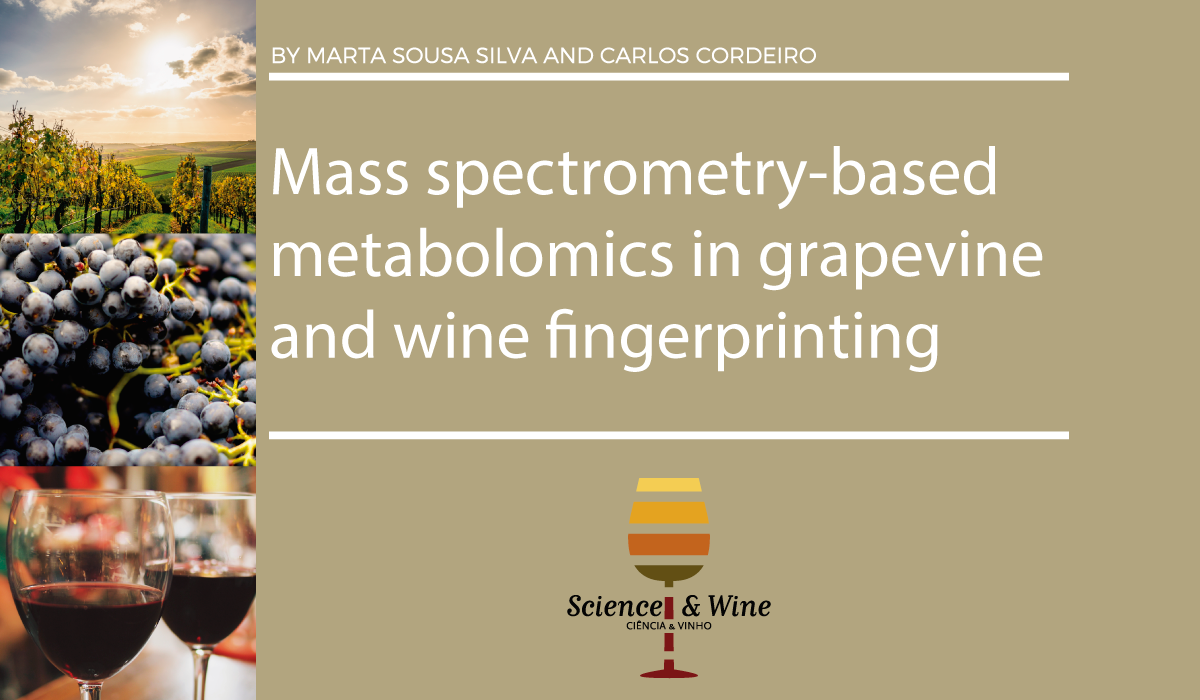By Marta Sousa Silva and Carlos Cordeiro
In the omics universe, the metabolome are the biochemical products that arise from cellular processes and is the final response of a biological system to environmental or genetic changes. Being highly dynamic and time-dependent, metabolomes are exquisitely complex (Aretz and Meierhofer, 2016). In plants, it is predicted that more than 200,000 metabolites are involved in physiological processes, in controlling plant growth and development and plant responses to environmental changes or biotic stresses (Fiehn, 2002). Besides their importance for plant physiology, there is a wide range of compounds with high nutritional value, organoleptic properties and potential human health benefits, which is particularly relevant in crop plants. Due to its economic importance in the wine industry, grapevine (Vitis vinifera L.) is one of the most important fruit plants cultivated worldwide. The characterization of the grapevine’s metabolome is essential to understand its physiology, its response to stress conditions, improve resistance to pathogens, increase productivity, quality and assess food safety. Concerning wine, one of the most widely appreciated drinks worldwide, its metabolome results from a complex process, involving grapes, yeast, bacteria, terroir effects and its ageing in wooden barrels. Wine metabolome fingerprint tells the story of its origin, production and quality. Its characterization is of paramount importance for quality control, authenticity and quality improvement. Wine metabolome characterization remains one the greatest challenges of analytical chemistry and biochemistry that challenges all conventional approaches to metabolomics. Indeed, metabolome characterization is often achieved through integrated analytical technologies such as nuclear magnetic resonance spectroscopy (NMR) and a combination of different mass spectrometry (MS)-based methods. Over the last five years, MS-based metabolomics superseded NMR-based metabolomics, because of its higher sensitivity, selectivity, number of compounds detected and identified, as well as the ability to perform very high-throughput assays (Markley et al, 2017; Sousa Silva et al, 2019). Typical MS-based metabolomics experiments are performed using liquid (LC) or gas (GC) chromatography coupled to MS instruments. The choice for one or both technologies depends on the chemical characteristics of the molecules of interest and the sensitivity and speed of the instrument, often resulting in the identification of dozens to hundreds of compounds (Boccard et al, 2010).

LC-MS and GC-MS technologies have been widely used in grapevine’s metabolic profiling, mainly in a targeted approach for the characterization of specific classes of secondary metabolites from grapes, leaves and stems (Anesi et al, 2015; Billet et al, 2018; Monagas et al, 2006; Souquet et al, 2000). These studies pointed out grapevine as a potential source of bioactive ingredients with antioxidant properties, paved the way to grapevine genotype discrimination based on a small picture of their metabolism, and confirmed the terroir effect in the grape’s metabolic profile, from the same grapevine cultivar. In wine analysis by LC- or GC-MS, the main target are phenolic compounds, as they contribute to the colour, astringency, bitterness and aroma of wine, sugars and aminoacids (Cuadros-Inostroza et al, 2016; Monagas et al, 2007; Rubert et al, 2014). Despite these promising results, only small subset of these metabolomes was uncovered.
The analysis of extremely complex samples calls for disruptive analytical techniques, able to provide extreme resolution to resolve tens of thousands of individual compounds in very high-throughput assays, without the need for time-consuming chromatographic separation. At present, Fourier transform ion cyclotron resonance mass spectrometry (FT-ICR-MS) provides the ultra-highest mass resolution available, with the latest instrument developed (Bruker Daltonics) able to exceed 20 million resolution. This technology is bringing grapevine and wine research to a higher level. In our group, we have been developing methods for metabolite extraction from grapevine leaves compatible with direct infusion-FTICR-MS-based metabolomics (Maia et al, 2016), capable to identify thousands of chemical species in a few minutes, to perform a thorough metabolome characterization of grapevine leaves, validating their valorisation as a source of bioactive compounds with high nutritional and nutraceutical value (Maia et al, 2019). Grapes and their corresponding wines are also discriminated based on their chemical fingerprints, and the effect of the terroir in their composition was confirmed to an unprecedent depth (Roullier-Gall et al, 2014a; Roullier-Gall et al, 2014b). And, although it is possible to characterize ten years of wine bottle ageing through its chemical profile (Karbowiak et al, 2019), only FT-ICR-MS uncovered the comprehensive chemical signatures still present in 170-year-old champagne bottles recovered from the Baltic Sea (Jeandet et al, 2015). This work contributed to the knowledge of the winemaking process used in Champagne at mid-19th century, giving an invaluable input for the World’s cultural heritage. FT-ICR-MS is thus poised to revolutionise our understanding of wine, from grapevine to glass.
Acknowledgments
We acknowledge the support from projects PTDC/BAA-MOL/28675/2017 and CEECIND/02246/2017 (to MS) from Fundação para a Ciência e Tecnologia (Portugal), from the Portuguese Mass Spectrometry Network (LISBOA-01-0145-FEDER-022125) and the Project EU_FT-ICR_MS, funded by the Europe and Union’s Horizon 2020 research and innovation programme under grant agreement no. 731077.

Marta Sousa Silva
Principal Researcher (CEEC-FCT) at Laboratório de FT-ICR e Espectrometria de Massa Estrutural – Ciências, Universidade de Lisboa (http://ft-icr.rd.ciencias.ulisboa.pt/). Science Manager of the Portuguese Centre in the European FT-ICR MS consortium (http://www.eu-fticr-ms.eu/). Member of the Steering Committee of the Portuguese Mass Spectrometry Network (RNEM) and Expert in the Groups “Analytical Methods” and “Viticulture” of the National Commission of the International Organization of Vine and Wine (Comissão Nacional da Organização Internacional da Vinha e do Vinho, CNOIV). Molecular Biologist, research focused in metabolomics and metabolic pathway analysis.
https://orcid.org/0000-0002-3080-9682

Carlos Cordeiro
Associate Professor with Habilitation at Faculdade de Ciências da Universidade de Lisboa. Director of the Laboratório de FT-ICR e Espectrometria de Massa Estrutural – Ciências (http://ft-icr.rd.ciencias.ulisboa.pt/), Vice-Coordinator of the Portuguese Mass Spectrometry Network (RNEM), PI of the Portuguese Center in the European FT-ICR MS consortium (http://www.eu-fticr-ms.eu/). Expert in the Group “Analytical Methods” of the National Commission of the International Organization of Vine and Wine (Comissão Nacional da Organização Internacional da Vinha e do Vinho, CNOIV). Experience in analytical biochemistry, chromatography and mass spectrometry, FT-ICR-MS and native MS, introducing both technologies in Portugal.
http://orcid.org/0000-0001-6327-8606
References
- Anesi, A; Stocchero, M; Dal Santo, S; Commisso, M; Zenoni, S; Ceoldo, S; Tornielli, G; Siebert, TE; Herderich, M; Pezzotti, M; Guzzo, F (2015) Towards a scientific interpretation of the terroir concept: plasticity of the grape berry metabolome. BMC PLANT BIOLOGY 15, 191. Doi 10.1186/s12870-015-0584-4
- Aretz, I; Meierhofer, D (2016) Advantages and Pitfalls of Mass Spectrometry Based Metabolome Profiling in Systems Biology. INTERNATIONAL JOURNAL OF MOLECULAR SCIENCES 17 (5), 632. Doi 10.3390/ijms17050632
- Billet, K; Houille, B; de Bernonville, TD; Besseau, S; Oudin, A; Courdavault, V; Delanoue, G; Guerin, L; Clastre, M; Giglioli-Guivarch, N; Lanoue, A (2018) Field-Based Metabolomics of Vitis vinifera L. Stems Provides New Insights for Genotype Discrimination and Polyphenol Metabolism Structuring. FRONTIERS IN PLANT SCIENCE 9, 798. Doi 10.3389/fpls.2018.00798
- Boccard, J; Veuthey, J-L; Rudaz, S (2010) Knowledge discovery in metabolomics: An overview of MS data handling. JOURNAL OF SEPARATION SCIENCE 33 (3), 290-304. Doi 10.1002/jssc.200900609
- Cuadros-Inostroza, Al; Ruiz-Lara, S; Gonzalez, E; Eckardt, A; Willmitzer, L; Pena-Cortes, H (2016) GC-MS metabolic profiling of Cabernet Sauvignon and Merlot cultivars during grapevine berry development and network analysis reveals a stage- and cultivar-dependent connectivity of primary metabolites. METABOLOMICS 12 (2), 39. Doi 10.1007/s11306-015-0927-z
- Fiehn, O (2002) Metabolomics – the link between genotypes and phenotypes. PLANT MOLECULAR BIOLOGY 48 (1-2), 155-171. Doi 10.1023/A:1013713905833
- Karbowiak, T; Crouvisier-Urion, K; Lagorce, A; Ballester, J; Geoffroy, A; Roullier-Gall, C; Chanut, J; Gougeon, RD; Schmitt-Kopplin, P; Bellat, JP (2019) Wine aging: a bottleneck story. NPJ SCIENCE OF FOOD 3, 14. Doi 10.1038/s41538-019-0045-9
- Maia, M; Monteiro, F; Sebastiana, M; Marques, AP; Ferreira, AEN; Ponces Freire, A; Cordeiro, C; Figueiredo, A; Sousa Silva, M (2016) Metabolite extraction for high-throughput FTICR-MS-based metabolomics in grapevine. EUPA OPEN PROTEOMICS 12, 4-9. Doi 10.1016/j.euprot.2016.03.002
- Maia, M; Ferreira, AEN; Laureano, G; Marques, AP; Torres, VM; Silva, AB; Matos, AR; Cordeiro, C; Figueiredo, A; Sousa Silva, M (2019) Vitis vinifera ‘Pinot noir’ leaves as a source of bioactive nutraceutical compounds. FOOD & FUNCTION 10 (7), 3822-3827. Doi 10.1039/c8fo02328j
- Markley, JL; Bruschweiler, R; Edison, AS; Eghbalnia, HR; Powers, R; Raftery, D; Wishart, DS (2017) The future of NMR-based metabolomics. CURRENT OPINION IN BIOTECHNOLOGY 43, 34-40. Doi 10.1016/j.copbio.2016.08.001
- Monagas, M; Bartolome, B; Gomez-Cordoves, C (2005) Updated knowledge about the presence of phenolic compounds in wine. CRITICAL REVIEWS IN FOOD SCIENCE AND NUTRITION 45 (2), 85-118. Doi 10.1080/10408690490911710
- Monagas, M; Hernandez-Ledesma, B; Gomez-Cordoves, C; Bartolome, B (2006) Commercial dietary ingredients from Vitis vinifera L. leaves and grape skins: Antioxidant and chemical characterization. JOURNAL OF AGRICULTURAL AND FOOD CHEMISTRY 54 (2), 319-327. Doi 10.1021/jf051807j
- Roullier-Gall, C; Boutegrabet, L; Gougeon, RD; Schmitt-Kopplin, P (2014) A grape and wine chemodiversity comparison of different appellations in Burgundy: Vintage vs terroir effects. FOOD CHEMISTRY 152, 100-107. Doi 10.1016/j.foodchem.2013.11.056
- Roullier-Gall, C; Lucio, M; Noret, L; Schmitt-Kopplin, P; Gougeon, RD (2014) How Subtle Is the “Terroir” Effect? Chemistry-Related Signatures of Two Climats de Bourgogne. PLOS ONE 9 (5), e97615. Doi 10.1371/journal.pone.0097615
- Rubert, J; Lacina, O; Fauhl-Hassek, C; Hajslova, J (2014) Metabolic fingerprinting based on high-resolution tandem mass spectrometry: a reliable tool for wine authentication? ANALYTICAL AND BIOANALYTICAL CHEMISTRY 406 (27), 6791-6803. Doi 10.1007/s00216-014-7864-y
- Sousa Silva, M; Cordeiro, C; Roessner, U; Figueiredo, A (2019) Editorial: Metabolomics in Crop Research-Current and Emerging Methodologies. FRONTIERS IN PLANT SCIENCE 10, 1013. Doi 10.3389/fpls.2019.01013
- Souquet, JM; Labarbe, B; Le Guerneve, C; Cheynier, V; Moutounet, M (2000) Phenolic composition of grape stems. JOURNAL OF AGRICULTURAL AND FOOD CHEMISTRY 48 (4), 1076-1080. Doi 10.1021/jf991171u

